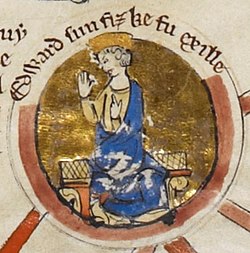Edward the Exile
| Edward the Exile | |
|---|---|
 Edward the Exile depicted on a medieval genealogical scroll. | |
| Born | 1016 |
| Died | 19 April 1057 (aged 40–41) England |
| Spouse | Agatha |
| Issue |
|
Ealdgyth | |
Edward the Exile (1016 – 19 April 1057), also called Edward Ætheling, was the son of King
Exile
After the
Return
On hearing that Edward was alive,
In 1054 King Edward sent Ealdred, Bishop of Worcester, to the court of the German emperor to set in train negotiations with the king of Hungary for the return of Edward the Exile. Ealdred was not at first successful, and in 1056 Earl Harold Godwinson's journey to Flanders, and possibly on to Germany and Hungary, was probably undertaken to further negotiations. The Exile finally arrived in England in 1057 with his wife and children, but died within a few days, on 19 April, without meeting the King. He was buried in Old St Paul's Cathedral.[7]
Family
Edward's wife was named
- King of England after the Battle of Hastings but submitted to William the Conqueror.
- Saint Margaret of Scotland (c. 1045 – 16 November 1093) - Married King Malcolm III of Scotland.
- Cristina (c. 1040 – c. 1093) - Abbess at Romsey Abbey.
Edward's grandchild
Ancestors
Edward the Exile was a direct descendant of a line of
| Ancestors of Edward the Exile | |||||||||||||||||||||||||||||||||||||||||||||||
|---|---|---|---|---|---|---|---|---|---|---|---|---|---|---|---|---|---|---|---|---|---|---|---|---|---|---|---|---|---|---|---|---|---|---|---|---|---|---|---|---|---|---|---|---|---|---|---|
| |||||||||||||||||||||||||||||||||||||||||||||||
See also
- House of Wessex family tree
References
- ^ Onslow, Earl of, The Dukes of Normandy and Their Origin, London, 1945, p.161.
- ^ Anderson, Alan O.,Scottish Annals from English Chroniclers, 500 to 1286, London, 1908. p.94n.
- ^ a b c von Redlich 1940, p. 107.
- ^ Kristó & Makk 1996, p. 69.
- ISBN 1-86064-061-3.
- ^ Barrow 2003, p. 35.
- ^ Keynes, Simon (May 1985). "The Crowland Psalter and the Sons of King Edmund Ironside". Bodleian Library Record. 11 (6): 363–364, 369, n. 31.
- ^ Lauder-Frost, Gregory M.S., FSA Scot.,"Agatha - The Ancestry Dispute" in The Scottish Genealogist, Edinburgh, Sept 2002, vol.xlix no.3, p.71-2.
- ^ Starkey, David (2004). The Monarchy of England: The Beginnings. Chatto and Windus. p. 88.
Sources
- Barrow, G. W. S. (2003). "Companions of the Atheling". Anglo-Norman Studies. XXV: 35–46. ISSN 0954-9927.
- ISBN 963-7930-97-3.
- von Redlich, Marcellus D. R. (1940). "The Parentage of Agatha, Wife of Prince Edward the Exile". The National Genealogical Society Quarterly. 28: 105–109.
Further reading
- de Vajay, Szabolcs (1962). "Agatha, mother of Saint Margaret Queen of Scotland". Duquesne Review. viii (2): 71–87. ISSN 0012-7205.
